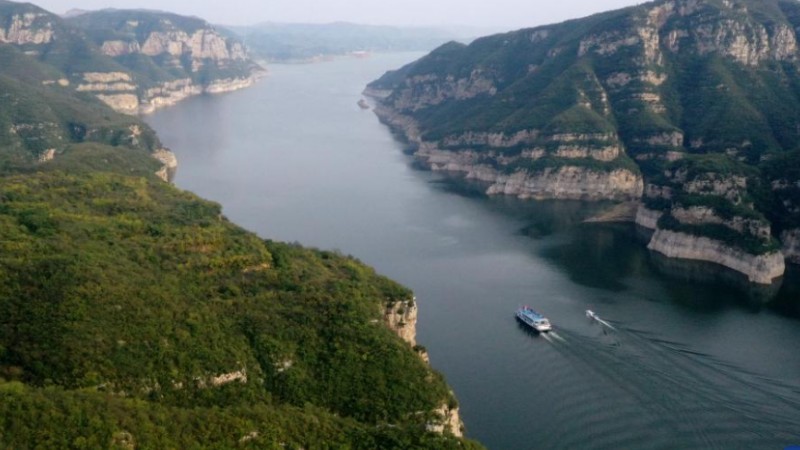BRI's global impact beyond flagship projects
BEIJING, Oct. 14 (Xinhua) -- The Peljesac Bridge, linking the Croatian mainland and the Peljesac Peninsula, the Jakarta-Bandung High-speed Railway, and Italy's pioneering semi-automatic terminal, Vado Gateway terminal, are globally renowned as key projects of the Belt and Road Initiative (BRI).
These projects, impressive as they may be, have earned their reputation not merely as structures, but for revitalizing local and regional economic growth in their respective areas.
The following are some facts, figures and coming-of-age stories of some flagship projects that underscore the broader impact of the China-proposed BRI, going beyond the provision of public goods.
CONNECTIVITY, PROSPERITY
As the famous Chinese saying goes: "Building the road is the first step towards prosperity." In a similar vein, infrastructure is a strong underpinning for a country's economic and social development, and the BRI projects have proven to precisely accommodate the development demand of participating countries.
Laos, a landlocked country in Southeast Asia, is one example of how modern infrastructure has boosted interconnectivity.
The economic development of Laos had long been restricted with only a 3.5 km-long railroad to Thailand. In December 2021, the 1,035-km China-Laos Railway, the first transnational railway built under the BRI, was launched, linking the Lao capital Vientiane, with the southwestern Chinese province of Yunnan.
Since its launch, the rail has become a game-changer for Laos, and an integral part of the country's economic and social landscape. Freight volume has significantly increased, and both domestic and international tourists now consider riding the Lane Xang electric multiple-unit trains on the China-Laos Railway a must-do experience.
Today, Laos has become a land-linked hub in the Indo-China Peninsula. Data shows that the railway had recorded a total of 20.79 million passenger trips and transported 25.22 million tonnes of cargo as of Aug. 31, 2023.
Not only is the land connectivity steadily improving, but BRI cooperation is also expanding in the maritime and aviation sectors of participating countries, contributing to local prosperity.
The Port of Piraeus, the largest port in Greece, was once on the brink of bankruptcy. Through Chinese investment in capital and advanced technologies and equipment under the BRI, it has seen its annual cargo throughput increase to above 5 million twenty-foot equivalent units (TEUs), making it the fourth largest TEU port in Europe.
In terms of air connectivity, China has signed bilateral air transport agreements with 104 BRI participating countries and opened direct flights with 57 partner countries to facilitate cross-border transport, according to official statistics.
INVESTMENT, EMPLOYMENT
In addition to transportation infrastructure, co-invested industrial parks and economic cooperation zones stand out as signature BRI projects, playing a clear role in promoting investment, trade and creating job opportunities for the locals.
The China-Egypt TEDA Suez Economic and Trade Cooperation Zone, for instance, is one demonstration project that aligns the BRI with the development of the Suez Canal Corridor.
Constructed in 2008, the cooperation zone supported Chinese enterprise Jushi to establish a subsidiary company in Egypt, which has enabled the Egyptian fiberglass industry to grow from scratch and made Egypt a major fiberglass producer in the world.
Over the past 15 years, the cooperation zone has attracted 145 companies to settle down, resulting in an investment of more than 1.7 billion U.S. dollars.
The Sihanoukville Special Economic Zone (SSEZ) in Cambodia, a joint venture between Chinese and Cambodian investors under the BRI, also shares a similar story.
Among the first batch of the overseas economic and trade cooperation zones, the 11-square-km SSEZ has so far accommodated some 175 companies from China, the United States, Europe, Southeast Asia and other regions, generating nearly 30,000 jobs, according to the zone's operator.
The World Bank has estimated that by 2030, BRI-related investments could lift 7.6 million people out of extreme poverty and 32 million people out of moderate poverty.
ENERGY, SUSTAINABILITY
Energy is high on the agenda among the 20-plus multilateral dialogue and cooperation mechanisms that BRI participating countries have launched, and green development is at the heart of BRI energy cooperation.
Since announcing that it would peak CO2 emissions before 2030 and achieve carbon neutrality before 2060, China has made substantial efforts to pursue greener development, which include vowing to stop building new coal-fired power stations overseas.
Walking the talk, the country has invested in and built a number of clean energy projects, aiming to contribute to the green and low-carbon development of the world. The Karot hydropower station, the first hydropower project under the China-Pakistan Economic Corridor which kicked off commercial operations in June 2022, is one of them.
In just over a year, the hydropower station has generated 3.64 billion kilowatt-hours of electricity, meeting the demands of more than 5 million residents.
Statistics indicate that China has carried out green energy project cooperation with more than 100 countries and regions, and the country's investment in BRI participating countries in terms of green and low-carbon energy has exceeded that for traditional energy.
According to China's top energy regulator, the country will continue to promote high-quality energy cooperation under the BRI, and build closer, greener and more inclusive energy partnerships in the future.
Photos
Related Stories
- Chilean president arrives in Beijing for 3rd Belt and Road Forum for Int'l Cooperation
- Macao SAR delegation to participate in 3rd Belt and Road Forum for Int'l Cooperation
- Hungarian prime minister arrives in Beijing for 3rd Belt and Road Forum for Int'l Cooperation
- Interview: BRI contributes to UN Sustainable Development Goals, UN official says
- Ethiopian PM arrives in Beijing for 3rd Belt and Road Forum for Int'l Cooperation
Copyright © 2023 People's Daily Online. All Rights Reserved.









